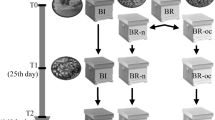Summary
In the haemolymph of honeybee drones, concentrations of free amino acids were higher than in worker haemolymph, with different relative proportions of individual amino acids. The overall concentration of free amino acids reached its highest level at the 5th day after adult drone emergence, and after the 9th day only minor changes in the concentration and distribution of free amino acids were observed. This coincides with the age when drones reach sexual maturity and change their feeding behaviour. Levels of essential free amino acids were high during the first 3 days of life and thereafter decreased. Osmolarity was lowest at emergence (334 ± 41 mOsm), increased until the age of 3 days (423 ± 32mOsm) and then stayed generally constant until the 16th day of life. Only 25-day-old drones had significantly higher osmolarity (532 ± 38 mOsm). The overall change in osmolarity during a drone's lifetime was about 40%.
Similar content being viewed by others
References
Berger B, Crailsheim K, Leonhard B (1997) Proline, leucine and phenylalanine metabolism in adult honeybee drones (Apis mellifica carnica Pollm.). Insect Biochem Molec Biol 27/6: 587–593
Buck JB (1953) Physical properties and chemical composition of insect blood. In: Roeder KD (ed) Insect physiology. John Wiley and Sons Inc, New York, pp 147–190
Cardinaud B, Coles J, Perrottet P, Spencer AJ, Osborne MP, Tsacopoulos M (1994) The composition of the interstitial fluid in the retina of the honeybee drone: implications for the supply of substrates of energy metabolism from blood to neurones. Proc R Soc Lond B 257: 9–58
Chen AC, Wagner RM (1992) Hemolymph constituents of the stable fly, Stomoxis calcitrans. Comp Biochem Physiol 102A: 133–137
Crailsheim K (1985) Distribution of haemolymph in the honeybee (Apis mellifica) in relation to season, age and temperature. J Insect Physiol 31: 707–713
Crailsheim K (1991) Interadult feeding of jelly in honeybee colonies (Apis mellifera L). J Comp Physiol B 161: 55–60
Crailsheim K (1992) The flow of jelly within a honeybee colony. J Comp Physiol B 162: 681–689
Crailsheim K, Leonhard B (1997) Amino acids in honeybee worker haemolymph. Amino Acids 13: 141–153
Crailsheim K, Schneider LH, Hrassnigg N, Bühlmann G, Brosch U, Gmeinbauer R, Schöffmann B (1992) Pollen consumption and utilization in worker honeybees (Apis mellifera carnica): dependence on individual age and function. J Insect Physiol 38: 409–419
Currie RW (1987) The biology and behaviour of drones. Bee World 68: 129–143 Florkin M, Jeuniaux Ch (1974) Hemolymph: composition. In: Rockstein M (ed) The physiology of insecta, 2nd edn. vol 5. Academic Press, New York, pp 255–307
Free JB (1957) The food of adult drone honeybees (Apis mellifera). Br J Anim Behav 5: 7–11
Free JB, Williams IH (1975) Factors determining the rearing and rejection of drones by the honeybee colony. Anim Behav 23: 650–675
Garrett MA, Bradley TJ (1987) Extracellular accumulation of proline, serine and trehalose in the haemolymph of osmoconforming brackish-water mosquitoes. J Exp Biol 129: 231–238
Gmeinbauer R, Crailsheim K (1993) Glucose utilisation during flight of honeybee (Apis mellifera) workers, drones and queens. J Insect Physiol 39: 959–967
Groot AP (1953) Protein and amino acid requirements of the honeybee (Apis mellifera L.). Physiol Comp Oecol 3: 197–285
Koeniger G (1988) Discrimination between different coloured queen models by free flying drones (Apis mellifera L.). Biona Report 6: 35–42
Lehnherr B, Lavanchy P, Wille M (1979) Pollensammeln 1978: 5. Eiweiß-und Aminosäuregehalt einiger häufiger Pollenarten. Schweiz Bienenzeitung 10: 482–488
Maurizio A (1954) Pollenerndhrung und Lebensvorgänge bei der Honigbiene (Apis mellifica L). Landw Jb Schweiz 68: 115–182
Mindt B (1962) Untersuchungen über das Leben der Drohnen, insbesondere Ernährung und Geschlechtsreife. Z Bienenforsch 6: 9–33
Nakayama S (1991) Osmotic pressure of haemolymph in the silkworm, Bombyx mori: changes in amino acid and cation concentrations during development. Appl Ent Zool 26: 99–105
Pabst MA, Pfeiler G (1994) The sperms of young drones of apis mellifera. Proc of the 13th Int Congr on Electron Microscopy 4a: 689–690
Pant R, Agrawal HC (1964) Free amino acids of the haemolymph of some insects. J Insect Physiol 10: 443–446
Panzenböck U, Crailsheim K (1997) Glycogen in honeybee queens, workers and drones (Apis mellifera carnica Pollm.). J Insect Physiol 43-2: 155–165
Ruttner F (1966) The life and flight activity of drones. Bee World 47: 93–100
Ruttner F (1985) Reproductive behaviour in honeybees. In: Hölldobler B, Lindauer M (eds) Experimental behavioral ecology. Fortschritte der Zoologie, vol 31. G Fischer, Stuttgart New York, pp 225–236
Sachs L (1972) Statistische Auswertungsmethoden, 3rd edn. Springer, Berlin, Heidelberg New York, pp 230–238
Sacktor B, Childress C (1967) Metabolism of proline in insect flight muscle and its significance in stimulating the oxidation of pyruvate. Arch Biochim Biophys 120: 583–588
Schneider LHW, Crailsheim K (1994) Die Verdnderungen von Hämolymph-und Flugparametern von Drohnen (Apis mellifera carnica Pollm) bei unterschiedlichen Klimabedingungen. Apidologie 25: 466–467
Szolderits MJ, Crailsheim K (1993) A comparison of pollen consumption and digestion in honeybee (Apis mellifera carnica) drones and workers. J Insect Physiol 39/10: 877–881
Tsacopoulos M (1995) Metabolite exchanges and signal trafficking between glial cells and photoreceptor- neurons in the honeybee retina. Verh Dtsch Zool Ges 88.2: 53–59
Tsacopoulos M, Veuthey AL, Saravelos SG, Perrottet P, Tsoupras G (1994) Glial cells transform glucose to alanine, which fuelsneurones in the honeybee retina. J Neurosci 14: 1339–1351
Vallet AM, Coles JA (1993) The perception of small objects by the drone honeybee. J Comp Physiol A 172: 183–188
Weiss K (1962) Untersuchungen über die Drohnenerzeugung im Bienenvolk. Archiv für Bienenkunde 39: 1–7
Author information
Authors and Affiliations
Rights and permissions
About this article
Cite this article
Leonhard, B., Crailsheim, K. Amino acids and osmolarity in honeybee drone haemolymph. Amino Acids 17, 195–205 (1999). https://doi.org/10.1007/BF01361882
Received:
Accepted:
Issue Date:
DOI: https://doi.org/10.1007/BF01361882




